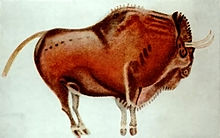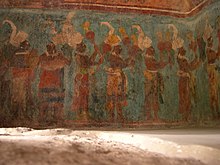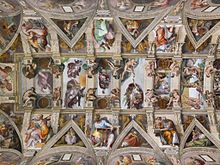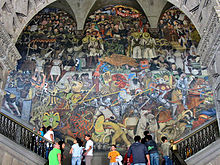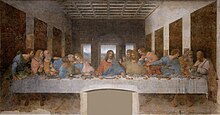Wall painting
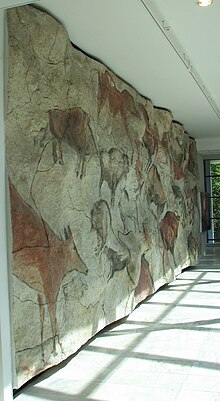

Wall painting is a form of painting in which the picture is not applied to a wooden panel or canvas , as is the case with panel painting , and is intended for mobile use, but is applied to a wall or ceiling in such a way that it is firmly connected to the surface . Alongside sculpture, wall painting is the oldest traditional cultural achievement of mankind.
With a wall painting, the artist tries to preserve the characteristic flatness of the wall ( strict wall painting ) or to create the impression of three-dimensionality ( illusionistic wall painting ).
history
Early days
Wall painting is one of the earliest cultural achievements of mankind. With the help of the radiocarbon method , the origin of the first cave paintings could be traced back to around 31,500 years BC. To date. The 18,000-year-old images of bison , horses and aurochs on the rock faces, discovered in 1940 by two boys in the caves of Lascaux in France, are already evidence of an almost abstract mastery of the artists of the Neolithic .
Other evidence of wall paintings from the younger Neolithic can be found in Çatalhöyük (approx. 6000 BC), where these paintings are particularly well preserved and probably adorned cult rooms. Wall paintings from this period can also be found in other places in the Middle East , but mostly less well preserved.
Egypt

Numerous wall paintings have been preserved in the burial chapels of the ancient Egyptians . These wall paintings were mainly used for the necessary additions according to Egyptian belief to 'survive' in the other world, which the dead could then dispose of there in this way. There are many depictions of food preparation or workshops in which the deceased could "manufacture" necessary equipment. On the one hand, they should guarantee survival in the afterlife, but also, as a status symbol, demonstrate the wealth of the deceased in the world of the dead. Garden representations reflect the ideas of the artists of the time of the appearance of the other world. Often these wall paintings also had religious and ceremonial significance and, due to their narrative imagery, were also intended to inform those unfamiliar with hieroglyphics clearly about the subjects presented.
Even secular buildings were decorated with wall paintings at this time, but very few examples of such designs have survived due to the poorer protection. In the Old Kingdom and Middle Kingdom (approx. 3000–1550 BC) monochrome paintings dominated , and figurative representations have also been known since the New Kingdom . The palaces in Malqatta and Amarna in particular were decorated with polychrome wall paintings. Here one finds representations of Nile landscapes, the rulers and their servants; there are also images of subjugated enemies, with which military successes for contemporaries and descendants should be recorded. The pictures often make direct reference to the function of the room. The wall paintings in the houses of high officials, on the other hand, served more decorative purposes and showed predominantly geometric and vegetable motifs.
Middle East
In the Middle East , especially residential buildings and palaces were decorated with wall paintings, of which, apart from a few remains, only fragments have survived. Well-preserved paintings with lion and leopard motifs can be seen in the temple of Tell Uqair , dating back to around 3000 BC. Is dated. There are also figurative paintings in the palace of Mari (date of origin around 1800 BC). A palace in Nuzi and an Assyrian governor's palace in Til Barsip provide further examples of rich decoration .
Aegean
Wall painting experienced a particular heyday (from approx. 1650 BC to 1250 BC) in the Aegean region, where palaces ( Knossos on Crete) and houses ( Akrotiri on Santorini) were painted in very intense colors. These paintings are usually done using the fresco technique, while those in Egypt and the Near East are mostly secco paintings. There are garden landscapes and figurative scenes, which differ primarily in their liveliness and the depiction of motion sequences from the paintings that were created at the same time in the Near East. The so-called Minoan style became so famous, however, that kings in Egypt ( Tell el-Daba ) and subsequently also in the Near East ( Alalach ) brought artists who paint in this style to their courts and had their palaces decorated by them. The Aegean influence also had an effect on Egyptian paintings.
Classical antiquity
Europe
Although, in contrast to vase painting, almost no wall paintings from ancient Greece have survived , the artists of this time seem to have mastered illusionist wall painting almost perfectly, as a competition handed down from Pliny the Elder between the artists Zeuxis of Herakleia and Parrhasios around 400 BC. BC shows: Zeuxis depicted the grapes in his mural so deceptively real that they would have lured birds. Parrhasios, on the other hand, had reproduced a curtain in his picture so faithfully that Zeuxios asked for the curtain to be removed so that the entire picture could be assessed. When Zeuxis realized his mistake, he was ashamed to award the prize to Parrhasios, since he himself could have deceived the animal, but the latter had deceived the artist.
In Etruria , a region around Lake Trasimeno in Italy that is predominantly populated by bronze and ceramic craftsmen , there are predominantly painted grave chambers from this period. As in ancient Egypt, the themes of the Etruscan murals were situations from this world that were believed to have a positive effect on the life of the deceased in the hereafter. So mainly joys in life such as B. Banquets shown.
In the Roman Empire , almost every homeowner who belonged to an upper class afforded the walls of his house to be painted. As widespread as it was here, at least measured by the number of inhabitants, wall painting was never again. This development began with the Greeks before the turn of the ages, but reached its climax in the first century AD in the Roman Empire , where the villas of wealthy citizens were painted even in the most remote provinces. The development of Roman wall painting is divided into different styles (1st – 4th Pompeian style ). Due to the eruption of Vesuvius in 79, whose ash rain buried the cities of Pompeii and Herculaneum and sealed them off airtight, numerous wall paintings in the villas of the wealthy citizens of Rome who had their country residences have been preserved in an almost intact condition. During the excavations that began in the 18th century, however, many murals were irretrievably destroyed by improper handling or in order to keep the fragments removed and moved elsewhere as small as possible and thus valuable.
In the third century AD, wall painting evidently began to decline; From the following period only a few examples of this art form can be found and this mostly only in sacred buildings. In ancient Rome and Byzantium , wall painting was often replaced and / or supplemented by mosaic , partly because of its better durability .
Asia

Wall painting was certainly a widespread art form among the Parthians and Sassanids , but these works are often only preserved in fragments. Parthian painting is characterized by a strong frontality, while the Sassanids that followed them preferred representations in profile.
Wall painting also experienced widespread use in Central Asia, especially with the spread of Buddhism . Buddha's sanctuaries were often richly painted with scenes from his life, and there are also numerous painted cave shrines in Central Asia . This flowering ended in many places with the emergence of Islam, which was rather hostile to images (see ban on images in Islam ). In India, the Buddhist rock paintings in the Ajanta caves are considered masterpieces of this era. Later works in Ajanta as well as Hindu, Jainist and Buddhist representations in the caves of Ellora continued the Gupta style.
In China, especially in the Tang dynasty, the monumental tombs of high court officials and members of the royal family were painted. In China there are also numerous Buddhist temples, built into caves that are decorated with wall paintings. Tibetan Buddhist wall paintings are a separate variety of Buddhism in Tibet .
In the Shekhawati region in northern India ( Rajasthan ), especially in Mandawa , there are still several merchant houses ( havelis ) painted in the 19th and early 20th centuries with naive and religious themes . But also in some rural regions of India the mud houses were painted with geometric or floral ornaments that have been handed down by the residents over centuries.
Africa
Numerous wall paintings are known from Nubia . Nubia was largely Christian from around 500 to 1500 and most of the churches there were painted with scenes from the Bible. The style of the paintings was strongly based on Byzantine models. Here, too, the tradition of wall painting ends with the arrival of Islam.
Central America
The art of wall painting flourished especially among the Mayans . Well-preserved examples were found in San Bartolo , where they adorned the walls of a burial chamber. In Bonampak they can be found in a temple. The pictures cover an area of 144 m² in three rooms. The ruler and his entourage, tribute and war scenes, a criminal court, dance scenes and blood sacrifices by nobles are depicted. The wall paintings give a unique insight into the social structure of Mayan society in the second half of the 1st millennium a. Z.
Central Europe
Archaeologists discovered during excavations on the new ICE line Erfurt-Leipzig / Halle in a prehistoric settlement near Wennungen in the Burgenland district a painted wall made up of around 1500 individual pieces, weighing around 200 kilograms in total. According to H. Meller, this is the largest find of wall paintings from the Iron Age north of the Alps to date. The archaeologists were able to use the parts to restore a piece of wall around two meters long and one and a half meters high. Possibly the painted wall adorned the front of an important building. The dominant colors of the painting were red, beige and white. The dye was hematite, also known as red chalk. In addition to typical ornaments from the Iron Age such as triangles and so-called S-hooks, ornaments of a symbolic character can also be recognized.
middle Ages
Romanesque

In the Romanesque period (1000–1200) wall painting experienced a great boom due to Christianization . The churches were adorned with biblical representations for those unfamiliar with reading, to acquaint them with the gospel . ( See : Church painting .) There were also wall paintings on castles , albeit with secular subjects. Impressive examples are the scenes from the Third Crusade at Gamburg Castle and the Iwein cycle at Rodenegg Castle in South Tyrol .
Since these are very old buildings that were subsequently changed or torn down, Romanesque wall paintings have mostly only survived in a damaged condition or, as in the Sigward Church (Idensen) , were only exposed again in modern times. The church was built between 1129 and 1134 by Bishop Sigward von Minden and consecrated to Saint Ursula and the eleven thousand virgins. Around 1500 the Romanesque painting was whitewashed with white lime and was only partially rediscovered in 1858. In the years 1930 to 1934 the painting was finally completely exposed.
Like other works of the Romanesque period, the wall paintings are characterized primarily by a low level of naturalism and high symbolism , which is also characteristic of the sculpture of this time or the Stone Bible . Hierarchical structures are often represented by the perspective of meaning and tiered arrangement.
Gothic

In the Gothic period , which originated in the Île-de-France (area around Paris ) around 1140 and lasted north of the Alps until around 1500, wall painting is the most important interior decoration of sacred buildings alongside glass painting . While wall painting subsequently became less important than glass painting north of the Alps and was replaced by panel painting , Italy continued to be a center of wall painting, which then experienced an additional boom in the subsequent Renaissance .
A highlight of the Gothic fresco are the works of Giotto di Bondone (1266–1337) with a previously unknown naturalism . He enlivens the pictorial space with depth and responds to each of his figures individually in facial expressions and gestures.
Cimabue had already taken the first steps towards naturalism . Although his works remain very Byzantine , they are already gaining some depth. He is followed by Duccio , whose painting, with its flowing lines, loosely falling robes and already increased depth, suggests the new style, but does not yet break away from the old Gothic representation. This was left to Giotto di Bondone only. In his paintings, all the elements of a picture came together to form a coherent unit, which meant a significant advance in painting. It was so far ahead of its time that although it clearly belongs to the Gothic period, it is often referred to as a pioneer of the Renaissance .
Wall painting was one of the most important steps in the cultural development towards our modern visual perception , especially as the forerunner of panel painting .
The largest inventory of secular wall paintings from the Middle Ages is considered to be the painting of Runkelstein Castle near Bolzano , commissioned by Niklaus Vintler between 1390 and 1410 , which extends over eight rooms and large parts of the exterior facades in the courtyard and includes courtly scenes as well as literary material.
Renaissance

One of the best known examples of mural painting in the Renaissance, which covers a period from the late 14th century until the 16th century, is The Last Supper by Leonardo da Vinci . Da Vinci used the order of the Milanese Duke Ludovico il Moro , the north wall of the refectory (dining room) of the Dominican church of Santa Maria delle Grazie to provide Milan with a mural, to his attempts by him to be cumbersome perceived fresco painting in a secco to carry out with self-developed colors, to try them out on an object. The work, which was created between 1494 and 1498, quickly showed signs of aging due to the inadequate durability of the color mixtures used by Da Vinci and an additional underground water vein running under the room, which polluted the room with moisture, which has made extensive restoration work necessary to this day.
The high point of painting using the fresco technique is generally considered to be the wall and ceiling painting of the Sistine Chapel , which Michelangelo (Buonarroti) carried out between 1508 and 1512 on behalf of Pope Julius II . It was unveiled on November 1st, 1512 and shows scenes from Genesis on a total of 520 m² with 115 larger-than-life characters.
Baroque
In the Baroque period (approx. 1600–1770) the importance of wall painting increased again, especially in the form of ceiling painting . In a virtuoso manner, architectural elements were carried forward into the sky and allegories defying the gravity of the earthly world were projected into the imaginary air space. An outstanding example is the ceiling painting in the stairwell of the Würzburg residence by Giovanni Battista Tiepolo , which claims to be the largest connected ceiling fresco in the world and is considered to be the artist's main work. In the years 1750–1753, the elder Tiepolo (father of Giovanni Domenico Tiepolo , who was also an important mural painter ) depicted the four continents with their people and vegetation. In particular, illusionistic ceiling openings were often used in baroque churches to give the faithful a direct look into, so to speak to enable heaven. In this respect, the baroque ceiling painting continued the "opening" of the ceiling, which was already discovered in the Renaissance , as a view of the sky. An example of this in are Parma executed dome frescoes by Antonio da Correggio .
In the Roman Baroque, ceiling painting finally became an essential means of counter-Reformation church furnishings based on the models of the frescoes in the churches Il Gesù by Giovanni Battista Gaulli and in Sant'Ignazio di Loyola in Campo Marzio by Andrea Pozzo . The wall and ceiling painting of the Baroque and Rococo tried to pull the viewer completely under the spell of religion or absolutist power .
A special form of wall painting is the Lüftlmalerei , which is still practiced today in the villages of the Alpine valleys. Well-known examples of such facade designs from the 18th and 19th centuries can be found in Mittenwald , Garmisch and in Unter- and Oberammergau .
Modern
socialism
In socialist states in the 20th century, hopes for the formation of a new society were often expressed in colorful, sometimes futuristic images of a positive image of human beings and of technical achievements.
Mexican movement
In Mexico, after the Mexican Revolution, a special school of muralistas emerged , the most famous representatives of this school are Diego Rivera , David Alfaro Siqueiros and José Clemente Orozco . The Mexican muralistas were political artists, partly committed to Marxism , but artistically referred to both native Mexican and European traditions of painting. Diego Rivera achieved world fame with his unmistakable murales , wall paintings with political motifs, which he created mainly in Mexico and the United States from 1922. When he in the same year with his first large-scale mural creation began, he was preparing thus the way for the development of fresco painting one of the leading art forms of the 20th century. At the same time he was a co-founder of the union of revolutionary painters, sculptors and graphic artists and joined the Partido Comunista Mexicano , from which he was excluded in 1929, among other things, due to differences in the depiction of Josef Stalin in one of his murals. He was similarly stubborn in 1933 while working on a monumental painting in the Rockefeller Center in New York City , which he was to carry out on behalf of John D. Rockefeller . When he refused to remove a portrait of Lenin , the work on behalf of Rockefeller was completely destroyed. Despite his exclusion from the party, Rivera was a staunch communist until his death and was instrumental in getting Leon Trotsky , an opponent of Stalin, a visa for Mexico and accommodation.
Street art


With 600 m² one of the largest murals in Europe was created in 1968 by the artists Werner Nöfer and Dieter Glasmacher in Hamburg-St. Pauli on the Great Freedom .
Wall painting was also used for propaganda in modern times, especially in Socialist Realism . Bold political statements were displayed on a large area, for example in company canteens or in public places. In many countries, however, political messages of controversial content are also painted by anonymous artists on public or private walls.
In Sardinia there are many wall paintings known as murals , mainly in mountain villages . In some villages there, especially in Orgosolo , the images are omnipresent. The oldest wall paintings there refer to the moderate struggle for freedom that the Sardinians, striving for independence, waged against the central power Italy. Orgosolo was a major resistance nest. More recent portraits tend to comment on world politics; B. September 11, 2001, or even contain advertising messages.
Influenced by Mexican artists such as David Alfaro Siqueiros , Pinuccio Sciola began realizing the first murales in San Sperate in 1968 . The artist is also known as the sculptor of the sound stones .
The cities of Belfast and Derry in Northern Ireland are also famous for their murals . In the purely Catholic and Protestant residential areas there, there were repeatedly politically motivated unrest, the so-called troubles . Events of these disputes are recorded in these murals. Also famous are the murals of the CitéCréation in Lyon , which are now presented on separate city tours. The French artist group CitéCréation has created over 500 facade works of art worldwide since it was founded in 1978 (as of 2011).
Graffiti is a contemporary form of wall painting . Large-scale, connected works with a statement that goes beyond mere tagging are also referred to as murals using the English term for wall painting .
Wall painting in today's interior design
After Art Nouveau, wall painting lost its importance in interior design. With the exception of a few notable color designs within the framework of the Bauhaus and by Le Corbusier and Bruno Taut , the architects of classical modernism preferred the color of the material and, for wall designs, monochrome, especially light to white colors.
In the mid-1980s, however, there was a revival of wall painting in interior design . This was due, among other things, to a growing boredom with the previous minimalist room design, which was perceived as cool and which no longer reflected the lifestyle of the 1980s. As early as 1990, a considerable increase in wall painting and the colored design of walls in interior design could be observed in Germany. Newly developed and easy-to-use colors, which allowed artists to deal with the subject in an uncomplicated and free manner, with maximum durability, supported this development. So were z. B. the acrylic paints suitable for damp rooms can also be used in swimming pools or the wellness landscapes emerging at this time.
The artist Graham Rust is an important representative of this new wall painting movement .
Since the 1990s, paintings have firmly established themselves again as wall decorations in contemporary home decor, despite sometimes considerable production costs. Today wall painting is divided into different areas, the artistic value of which is assessed differently. A distinction must be made between illusion paintings , ornamental wall designs, wallpaper paintings or historicizing surfaces such as marble imitations and stenciling techniques , as well as special forms, which include light shaft paintings that are common on Sylt , for example .
Wall painting techniques
Manual techniques
There are basically three types of painting techniques used in manual production:
- al fresco
- al secco
- Production in the studio
al fresco

When al fresco , also fresh painting ( it. : Al fresco , "affresco" = the freshness) embodiments mentioned are the colors on the fresh plaster is applied, being in a chemical reaction with the plaster silicification and connect so insoluble with the ground . The finished wall or ceiling picture is called the fresco or the fresco . The performing artist is referred to as a fresco painter or fresco artist . This technique required quick and skilled painters. Before painting, a cleaner had to clean out the precisely outlined area that the artist wanted to create as a day's work . If the artist couldn't get the job done, the excess plaster had to be knocked off and reapplied the next day.
Frescoes are very durable. However, the range of pigments is reduced because you can only paint with alkali-resistant paints. Substances that react with lime and other substances that react in the plaster are also out of the question.
Today, the fresco technique is hardly taught at the usual art schools. Therefore, interested people attend courses with private lecturers. In Italy there is the fresco school by Leonetto Tintori in Tuscany and the Bottega Dell 'Affresco by Patrizia Gioia in Rome.
al secco
With secco painting , also called dry painting from the Italian al secco ( on dryness ), the colors are not applied to the fresh, still damp lime plaster, but to the already dry masonry. An artist can take more time for pictures using this technique.
However, there can be problems with durability, as the colors do not bond as closely to the wall as with the Fresco. In today's practice, on the one hand, mineral paints are used. Their pigments, similar to Fresco, bind closely to the plaster through a chemical process. In the germ technique , this is done by the potassium water glass contained in the mineral paint . It reacts with the ground to form a stable layer of silicate. On the other hand, water-soluble acrylic paints are used.
Production in the studio
With this method of execution, not only the draft and the templates or other templates for the mural are made in the artist's studio, but also the actual work itself. This is painted with oil , tempera or acrylic paints on a canvas that is adapted to the architectural conditions of the installation location which is then glued on on site or stretched with the help of a frame . This method was also used in earlier times because of the strenuous "overhead" work, especially when creating ceiling paintings.
Printing techniques
Wooden model printing
With wooden model printing , which is only rarely carried out today, the individual image motifs are printed on paper webs with a large number - up to several thousand for larger panoramas - of engraved wooden models , whereby contiguous panorama images up to a width of 20 meters were possible. This technique was used by manufacturers such as Zuber et Cie or Dufour et Cie to produce panoramic wallpapers in order to offer an alternative to the original frescoes and to make this form of decoration accessible to a larger public. The company Zuber et Cie from Rixheim in Alsace is, according to their statements, the only company in the world that still produces and sells wooden model prints.
One of the most famous panoramas from the wedding of these murals at the beginning of the 19th century was the Sauvages de la Mer du Pacifique , consisting of 20 panels and designed by the artist Jean-Gabriel Charvet for Dufour et Cie , which was just taking place at the time and is therefore very popular Illustrated exploration trips by Captain Cook to the South Seas. Another well-known motif is the “du Vue de l'Amérique Nord”, launched by Zuber et Cie in 1834 , a version of which is still in the diplomatic reception room of the White House in Washington .
Digital techniques
With the development of digital printing technology , with which pictures can be produced in seamless and seamless wall sizes, new possibilities opened up for a cost- and time-saving alternative for the production of wall pictures. For example, existing motifs can be scanned or photographed and reproduced in almost original quality.
Further applications arise for the artistic design of billboards , which were also painted by hand on canvases before the advent of digital printing technology, or in foil printing (wall tattoo). Digital printing technology has also enabled new manufacturing processes for wallpapers (for example gravure wallpapers with a three-dimensional structure), which also allow their individual design.
Due to the high resolution of new printers, printed murals have almost no difference in resolution and color accuracy compared to murals painted on canvas in the artist's studio and then applied to the wall on site. With the help of special printing techniques, it is even possible in some cases to imitate the roughness of hand-painted pictures.
See also
literature
- Kurt Wehlte : wall painting . Berlin 1938.
- Kurt Wehlte: Materials and techniques of painting . Stuttgart / Ravensburg 1967.
- Wall painting [including special ceiling paintings] In: Hans-Herbert Möller (Hrsg.): Restoration of cultural monuments. Examples from the preservation of historical monuments in Lower Saxony (= reports on historical preservation . Supplement 2). Lower Saxony State Administration Office - Institute for Monument Preservation . Niemeyer, Hameln 1989, ISBN 3-87585-152-8 , pp. 191-260.
- Norbert Martins: Gable fantasies - Berlin murals . HetStein-Verlag, Berlin 1989, ISBN 3-926976-07-1 .
- Norbert & Melanie Martins: House walls instead of canvases - Berlin murals . Berlin 2012, ISBN 978-3-00-038596-4 .
- Stephen Callway: Room Design in the 20th Century . Herford 1991.
- Johannes Klinger : Wall painting today. Callwey, Munich 1999, ISBN 3-7667-1316-7 .
- Johannes Klinger: Innovative wall painting. Deutsche Verlags-Anstalt, Munich 2002, ISBN 3-421-03397-8 .
- Johannes Klinger: Color and Light. Deutsche Verlags-Anstalt, Munich 2007, ISBN 978-3-421-03570-7 .
- Bettina Rodeck, Gerhard Meerwein, Frank H. Mahnke: Human - Color - Space . Leinfelden-Echterdingen 1998, ISBN 3-87422-629-8 .
- Painted illusions. Murals on houses. Series The Bibliophile Paperback Books . OMNIS Verlag, Berlin 1980, ISBN 3-88379-384-1 .
- Günter Woost: The wall painting in the light shafts of Sylt . Ed .: Horus Kunstmalerei GmbH, ISBN 3-00-035487-5 .
- Kiriakos Losifidis: Mural Art: Murals and Huge Public Surfaces around he World. Publikat Verlag, Mainaschaff 2008, ISBN 978-3-939566-22-9 .
- Kiriakos Losifidis: Mural Art. Vol. 2: Murals on Huge Public Surfaces around the World. Publikat Verlag, Mainaschaff 2009, ISBN 978-3-939566-27-4 .
- Kiriakos Losifidis: Mural Art. Vol. 3: Murals on Huge Public Surfaces around the World. Publikat Verlag, Mainaschaff 2010, ISBN 978-3-939566-28-1 .
- Claus Bernet : wall painting. Norderstedt 2014, ISBN 978-3-7347-3091-7 .
- Maximilian Rapp: Murals in Northern Ireland: Symbol of ethno-cultural identity and mirror of political change. Nomos, Baden-Baden 2014, ISBN 978-3-8487-1419-3 .
Web links
Prehistoric wall painting
Ancient wall painting
Historical wall painting
- Restoration and conservation of historical wall paintings
- Historical color slide archive for wall and ceiling painting 40,000 photos for wall and ceiling painting in Germany, Austria, Poland, Russia and the Czech Republic, created by the historical color slide archive for wall and ceiling painting between 1943 and 1945.
- www.wandmalerei-luebeck.de
- Patrizia Gioia - The ancient art of Fresco
Modern wall painting
- Mural Conservancy of Los Angeles (English)
- Political Murals in Ireland picture gallery and explanatory texts
- International Index of Modern Wall Painting
Individual evidence
- ↑ Guatemala's Oldest Maya Mural. ( Memento from June 9, 2007 in the web archive archive.today )
- ↑ Runkelstein Castle - The Picture Castle. on: runkelstein.info
- ^ Maximilian Rapp, Markus Rhomberg: The importance of Murals during the Troubles: Analyzing the republican use of wall paintings in Northern Ireland. In: D. Machin (Ed.): Visual Communication. De Gruyter, 2014, ISBN 978-3-11-025548-5 , p. 677ff.
- ^ Murals in the Diplomatic Reception Room of the White House
- ↑ Yes, they used to paint billboards ... By hand. ( Memento of the original from May 12, 2015 in the Internet Archive ) Info: The archive link was inserted automatically and has not yet been checked. Please check the original and archive link according to the instructions and then remove this notice.
- ↑ Roland Gööck: Inventions of mankind - health, food, living, building. Sigloch Edition, Blaufelden 2000, ISBN 3-89393-204-6 .
